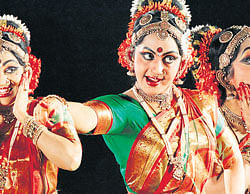She has been acknowledged as an outstanding dancer with a great gift for nritta, natya and abhinaya; a brilliant choreographer and a highly successful teacher.

Yet, Kuchipudi artiste Dr Sobha Naidu is the last one to sit back with a sense of satisfaction and rest on these hard-won laurels.
“I have got so much more to learn, such a long way to go. In fact, I find it difficult to look at videos of my dance — I keep finding so many flaws!” she says.
But then, she is a perfectionist. And much of this was imbibed from her guru, the legendary Vempati Chinna Satyam.
Known for a legion of famous disciples, Vempati was an uncompromising disciplinarian and a very exacting teacher. Sobha, one of his best-known students, recalls: “He was a very gentle human being but unrelenting when it came to standards of dance.”
Sobha has a string of awards and titles to her credit, including the Padmashree, and has performed extensively across the world and in India to much acclaim.
Leading critics have differently described her as “a boneless wonder” for her agility and the fluidity of her movements; a dancer of exceptional grace, and one with great command over the navarasas for the ease with which she displays a kaleidoscope of emotions.
A crowdpuller as performer, her portraits of Sathyabhama, Padmavathi and Chandalika are among her most celebrated roles. With a track record of 80 solo numbers and 15 ballets as choreographer, she has groomed over 1,500 students from India and overseas as a teacher. She has founded and runs the Kuchipudi Art Academy in Hyderabad.
But the path was far from easy. Born into a conservative family, she was dissuaded from taking to dance. But her mother who sensed her daughter’s passion for the art, encouraged her and after initial lessons from P L Reddy, took her to Chennai for tutelage under Vempati. Twelve years of rigorous sadhana followed.
Sobha’s father, who wanted her to become a medical doctor, had given his permission reluctantly for the move to Chennai and Sobha assured him she would stop performing after her arangetram.
But the morning after this debut, she received 10 performance offers and the momentum grew since then — even after her return to Hyderabad. “Here I learnt Carnatic music from Neti Srirama Sarma, but I wish I had learnt it as a child.”
Sobha is known for her unswerving devotion to classical dance, more specifically, Kuchipudi. Iconic Bharatanatyam guru Vazhuvoor Ramaiah Pillai was so impressed by her skills that he offered to teach her Bharatanatyam free of cost!
However, Sobha declined the offer saying though she admired Bharatanatyam and him tremendously, she felt one lifetime was not enough to learn Kuchipudi.
The doe-eyed dusky dancer with a sculpturesque figure received countless offers from south-Indian film producers and directors to act in films.
However, she politely refused all of them saying she wanted to focus on dance. For example, Sobha was the first choice for Sargam (remake of the Telugu hit Sirisiri Muvva).
“Filmmaker Nagi Reddy gave me a blank cheque, but I returned it to him with folded hands saying I respect cinema but cannot accept the offer. He was first taken aback, but then he stood up with folded hands saying: ‘I respect your dedication to classical dance’.”
Rukmini Devi Arundale, who attended her arangetram, instinctively realised she would be sought out by filmmakers, and made Sobha give her word of honour that she would never be tempted by film offers and would dedicate herself to classical dance.
“Actually, I had already made that decision as a young girl, but Rukminijee reinforced the resolve by insisting on a promise made by placing my hand in hers!”
For all this, Sobha realises that it is tough to make a living out of classical dance these days. Also, there is little encouragement from the Andhra Pradesh government for the state’s arts, she regrets.
“I tell my students not to expect to make a livelihood of classical dance. Learn it for self-satisfaction and not for fame, money or perks, I say. The aesthetic satisfaction, inner peace and therapeutic benefits classical dance gives outweigh rewards of money and fame.”
However, she also understands that classical dance is an expensive art to learn. To overcome this barrier and spread the art, she charges students a mere Rs 200 per month at her academy.
“When they hear of the figure, surprised parents ask me if I am quoting the fee per class or day! Everything I have in life today, I owe to dance, and this is my small way of paying back,” she says smilingly as she leaves us for the group of students waiting in the adjoining classroom.